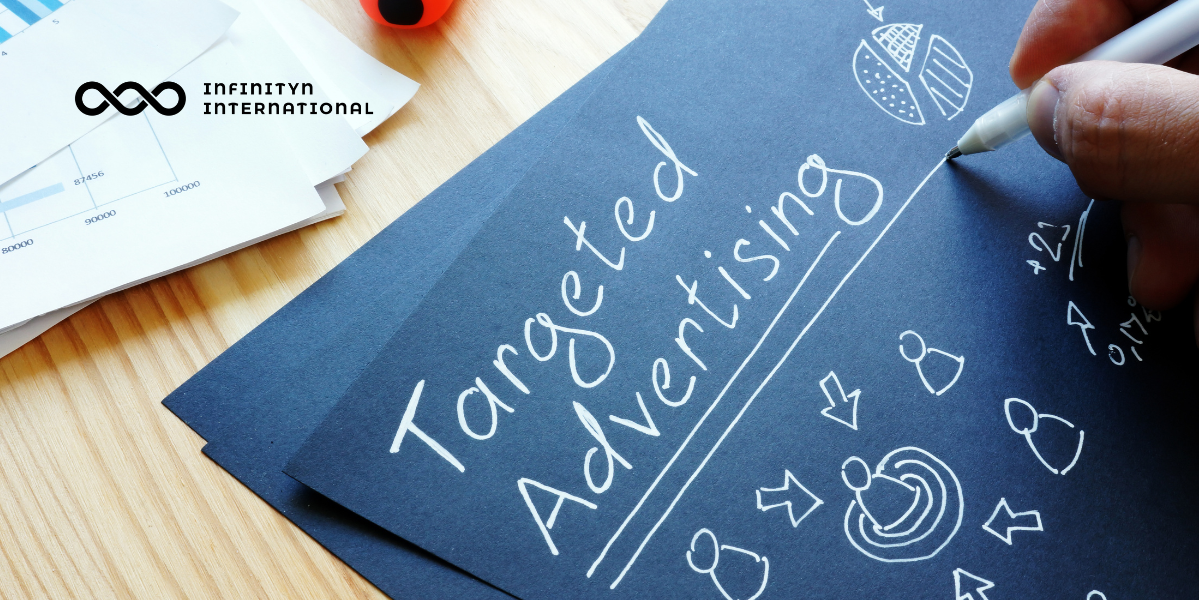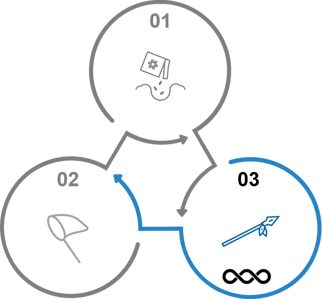From Volume to Value: Why Account-Based Advertising Wins in B2B
Traditional lead generation is a numbers game. Account-based is a relevance game.
5 min read
 Kate Varvedo
:
Mar 25, 2024 4:39:43 PM
Kate Varvedo
:
Mar 25, 2024 4:39:43 PM

In the ever-evolving landscape of digital advertising, the year 2024 marks a significant turning point, especially for B2B advertisers. With the impending demise of third-party cookies, the cornerstone of targeted advertising for years, advertisers are facing a paradigm shift in how they reach and engage their target audiences. To delve deeper into this transformative period and glean insights on winning target accounts in a post-third-party-cookie era, I recently had the opportunity to listen in a conversation with John Arnold, Principal B2B Advertising Analyst at Forrester, and Gareth Noonan, General Manager Advertising at Demandbase. (listen to the full podcase here)
The discussion revolved around the ramifications of post-cookie advertising, particularly focusing on targeting and measurement within Google's Chrome browser, which commands a significant share of the global market. As John Arnold explained, third-party cookies have traditionally provided advertisers with a granular level of data, allowing them to track user behaviour across various websites and tailor advertising strategies accordingly. However, with Chrome's decision to phase out third-party cookies, advertisers are compelled to adapt to alternative methodologies for audience targeting and measurement.
Chrome's shift towards grouping users into cohorts based on shared interests and behaviours signifies a departure from individual-level tracking to a more generalized approach. This transition poses challenges for advertisers accustomed to precise targeting, necessitating a re-evaluation of strategies to ensure continued effectiveness in reaching desired audiences.
The journey towards this pivotal moment in digital advertising began with Google's announcement of the Privacy Sandbox in 2019, serving as a testing ground for innovative targeting and measurement approaches. Subsequently, Google revealed its intent to eliminate third-party cookies from Chrome by the end of 2024, with incremental steps taken to gradually phase out cookie-based targeting. These developments underscore the urgency for advertisers to recalibrate their advertising tactics in alignment with evolving privacy regulations and consumer preferences.
It's worth noting that Chrome holds a staggering 65% of the market share, equating to roughly 3 billion users worldwide. However, this figure doesn't fully capture the landscape, as Safari and Firefox have already implemented similar changes in recent years. While their market shares are smaller, with Safari accounting for approximately 15 to 20%, and Firefox and other smaller browsers making up the remainder, their adoption of privacy-focused measures underscores the broader industry trend towards enhanced user data protection.
So, let me break down the challenges B2B advertisers are grappling with, and it goes beyond just cookies. There are these four big factors contributing to what Forrester calls B2B data deprecation: browser and operating system restrictions, shifts in business buyer behaviour, privacy regulations, and closed ecosystems. Each of these factors brings its own set of hurdles, from technical limitations to changes in how people view data privacy.
One thing Gareth Noonan (Demandbase) pointed out that caught my attention is this move towards anonymity in audience segmentation. As our usual targeting methods become less effective, we've got to adapt. Instead of focusing on individual users, we're looking more at pseudonymous audiences, which are groups of people with similar characteristics. This means leaning into things like firmographics, which are details about a company, rather than personal info about specific people. It's all about shifting our approach to more contextual targeting, finding ways to reach these anonymous audiences based on what they're interested in or the content they engage with.
In navigating these challenges, we have to underscore the importance of collaboration between marketing teams and key stakeholders such as legal and IT departments to ensure compliance with privacy regulations and company policies. Additionally, staying abreast of changes in closed ecosystems, such as LinkedIn's modifications to its APIs, is crucial for avoiding disruptions in data access and utilization.
As we venture into uncharted territory in the realm of B2B advertising, adaptability, and innovation emerge as indispensable qualities for advertisers seeking to thrive in a post-cookie era. By embracing anonymity, forging strategic partnerships, and leveraging emerging technologies, B2B advertisers can navigate the complexities of data deprecation and continue to deliver impactful and relevant experiences to their target audiences.
Strategies for Success in a Changing Landscape
Amidst these challenges lie opportunities for pioneering approaches to audience targeting and engagement.
Addressing the nuances of marketing to B2B audiences in a post-cookie era, industry experts emphasize the imperative of embracing addressability as a cornerstone of strategy. Traditionally, marketers have relied on individual-level targeting, prioritizing leads likely to convert into sales contacts. However, with the erosion of such methodologies, a paradigm shift towards addressability emerges as a pivotal strategy.
Forrester conducted a survey among B2B buyers, querying them about their responses to advertising over the past six months. What's particularly noteworthy is that the top three reactions did not involve clicks. Surprisingly, the most common action, reported by 92% of respondents, was using a search engine to research the company solution or topic highlighted in the ad. Following closely, 86% of participants visited the advertised website without clicking on the ad, while 77% shared the primary message from the advertisement with potentially interested colleagues. This highlights the significance of reaching the buying group collectively rather than solely focusing on individual ad clicks, aligning with the primary objective of advertising to synchronize the buying group's understanding and decision-making process.
Central to this approach is the recognition that audiences vary in their level of addressability. While some remain individually identifiable, such as existing customers with permission-based data, the majority fall into less individually addressable cohorts. Herein lies the challenge and the opportunity for marketers to refine their targeting strategies, leveraging a spectrum of addressable audiences, including account-based, role-based, and cohort-based segments.
When it comes to advertising, the goal is to engage the entire buying group and ensure everyone is aligned. However, relying solely on ad clicks won't achieve this objective. Other actions, such as interacting with promoted articles, search ads, and display ads, contribute significantly to audience engagement. This study also unveiled additional responses to ad impressions, including email responses and taking action on ads without clicking. By focusing solely on click-through-based attribution, advertisers risk undervaluing the impact of ad impressions. Moving forward, it's crucial to adopt more comprehensive measurement approaches, considering factors like cohort and account-based targeting. In essence, a multifaceted approach is essential for effective advertising in today's landscape.
As revealed by industry experts, the rise of connected TV (CTV) emerges as a promising avenue for B2B advertisers seeking alternative targeting options. With its robust IP-based targeting capabilities, CTV offers a compelling platform for reaching niche audiences effectively. Its compatibility with account-based marketing (ABM) principles further underscores its relevance as a strategic channel for B2B advertisers.
However, success in navigating the post-cookie landscape hinges on the strategic harnessing of first-party data. As emphasized by experts, building a robust first-party data asset is paramount, augmented by strategies for collecting zero-party data—information yet to be shared by audiences. By cultivating second-party relationships and leveraging identity graphs, advertisers can enrich their data layers, enhancing audience targeting and segmentation.
Furthermore, artificial intelligence (AI) emerges as a powerful ally in this endeavour, facilitating identity resolution, targeting, segmentation, personalization, and measurement. Predictive AI holds the potential to identify high-value audiences based on anonymous and pseudonymous attributes, enabling advertisers to optimize their targeting efforts effectively.
In parallel, a shift in measurement methodologies is imperative, with a pivot towards audience-based and outcome-based metrics. As traditional attribution models prove inadequate in capturing the nuanced behaviours of B2B audiences, a holistic approach to measurement becomes essential. By aligning measurement strategies with audience behaviours, advertisers can glean deeper insights into campaign effectiveness and optimize their strategies accordingly.
Among these transformations, specialized partnerships assume heightened significance. B2B advertisers are urged to collaborate with partners equipped with the expertise to navigate the intricacies of the post-cookie landscape. Specialized B2B DSPs offer tailored solutions designed to address the unique complexities of B2B advertising, leveraging technologies such as IP-based targeting and contextual intelligence to deliver impactful campaigns.
At the forefront of this evolution stands Demandbase, a leading player in B2B advertising solutions. Leveraging its participation in key industry forums and its innovative product offerings, such as High Intent Pages, Demandbase empowers advertisers to thrive in a post-cookie world. High Intent Pages, a contextual tool combining account identification with keyword sets, exemplifies the company's commitment to delivering cutting-edge solutions tailored to the needs of B2B advertisers.
Therefore, the advent of a post-cookie era heralds both challenges and opportunities for B2B advertisers. By embracing addressability, harnessing first-party data, leveraging AI-driven insights, and forging specialized partnerships, advertisers can chart a course toward success in the evolving landscape of B2B advertising. As industry experts assert, adaptability and innovation will be the hallmarks of success in this new frontier of advertising.

Traditional lead generation is a numbers game. Account-based is a relevance game.
.png)
There’s a point in every company’s growth when the numbers stop adding up. The leads keep coming, but the pipeline stalls. Meetings are booked, yet...

B2B advertising has a targeting problem. Most platforms weren’t built for the complex, multi-person sales journeys we see in real buying committees....
The world of Marketing and Sales is an exciting and rather hectic one – sometimes unpredictable and sometimes easy to calculate, but no matter what...
.png)
AI as Your New Creative Colleague in B2B Marketing If “doing more with less” had a face in 2025, it would look a lot like a creative team that just...

2 min read
Thirty years ago I sat in a training classroom and learned to colour bright red flags beside every missing stakeholder on my Strategic Selling...
 Read More
Read More

Account-Based Marketing or ABM has undoubtedly become a defining element of B2B business development. It has been constantly evolving and it’s not...

From Cold Outreach to Warm Connections: Infinityn X Sendoso Budapest, Hungary, 30/09/2025, Infinityn is happy to announce a strategic partnership...

The recent pandemic, economic slowdown, and accompanying uncertainty have resulted in a temporary interruption in how enterprises procure technology...

4 min read
Attending The Global ABM Conference in London last week sparked a thought-provoking question: could this event evolve into a broader forum, something...

Account-based marketing has been all the rage in the B2B world with big promises, new lingo, new buzzwords. We’ve been finding that it isn’t always...